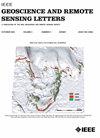HY-2B扫描微波辐射计对海表初始温度的估算
IF 4
3区 地球科学
Q2 ENGINEERING, ELECTRICAL & ELECTRONIC
引用次数: 10
摘要
海洋- 2b (HY-2B)是中国第二颗海洋动力环境卫星。对HY-2B卫星上扫描微波辐射计(SMR)的海表温度(SST)产品进行了原位测量评估。从2019年1月15日至2019年11月15日,大约10个月的数据用于初步评估。配置的时空窗口分别为30 min和25 km, HY-2B/SMR与原位SSTs之间产生450 416对匹配。整个数据集的统计比较表明,平均偏差为- 0.13°C (SMR减去浮标),相应的均方根误差(RMSE)为1.06°C。对6月15日以后的海温差进行时间序列拟合,发现hyb /SMR与原位海温吻合较好,平均偏差仅为0.09°C,均方根误差仅为0.72°C。对SMR、全球降水测量微波成像仪(GMI)和原位海温进行了三方面误差分析。GMI海温的个体标准差为0.41°C,原位海温为0.15°C, SMR海温为1.03°C。结果表明,2019年1月15日至2019年6月15日期间,HY2B/SMR海温产品有待改进。本文章由计算机程序翻译,如有差异,请以英文原文为准。
Evaluation of the Initial Sea Surface Temperature From the HY-2B Scanning Microwave Radiometer
Haiyang-2B (HY-2B) is the second marine dynamic environment satellite of China. Sea surface temperature (SST) products from the scanning microwave radiometer (SMR) onboard HY-2B satellite are evaluated against in situ measurements. Approximately, ten months of data are used for the initial evaluation, from January 15, 2019 to November 15, 2019. The temporal and spatial windows for collocation are 30 min and 25 km, respectively, which produce 450 416 matchup pairs between HY-2B/SMR and in situ SSTs. The statistical comparison of the entire data set shows that the mean bias is −0.13 °C (SMR minus buoy), and the corresponding root-mean-square error (RMSE) is 1.06 °C. Time series of collocations for the SST difference shows that a good agreement is found between HY-2B/SMR and in situ SSTs after June 15, revealing a mean bias and an RMSE of only 0.09 °C and 0.72 °C, respectively. A three-way error analysis is conducted between the SMR, Global Precipitation Measurement Microwave Imager (GMI), and in situ SSTs. Individual standard deviations are found to be 0.41 °C for the GMI SST, 0.15 °C for the in situ SST, and 1.03 °C for the SMR SST. The results indicate that the HY2B/SMR SST products need to be improved during the period from January 15, 2019 to June 15, 2019.
求助全文
通过发布文献求助,成功后即可免费获取论文全文。
去求助
来源期刊

IEEE Geoscience and Remote Sensing Letters
工程技术-地球化学与地球物理
CiteScore
7.60
自引率
12.50%
发文量
1113
审稿时长
3.4 months
期刊介绍:
IEEE Geoscience and Remote Sensing Letters (GRSL) is a monthly publication for short papers (maximum length 5 pages) addressing new ideas and formative concepts in remote sensing as well as important new and timely results and concepts. Papers should relate to the theory, concepts and techniques of science and engineering as applied to sensing the earth, oceans, atmosphere, and space, and the processing, interpretation, and dissemination of this information. The technical content of papers must be both new and significant. Experimental data must be complete and include sufficient description of experimental apparatus, methods, and relevant experimental conditions. GRSL encourages the incorporation of "extended objects" or "multimedia" such as animations to enhance the shorter papers.
 求助内容:
求助内容: 应助结果提醒方式:
应助结果提醒方式:


